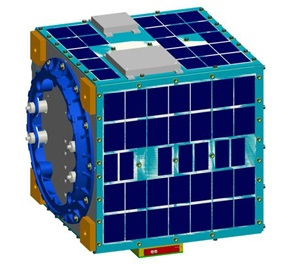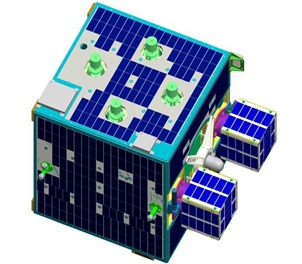
PN
Jump to: Mission Objectives, Mission Instrumentation, Mission Parameters, Additional Information
Mission Photos:
 |
 |
| APOD satellite conceptual drawings | |
| Courtesy of Beijing Aerospace Control Center (BACC). | |
Mission Objectives:
APOD (Atmospheric density Detection and Precise Orbit Determination) experimental satellites is an initiative project of China aiming at precise orbit determination and thermosphere density detection, which are designed and manufactured by DFH satellite Co. Ltd (DFH), and managed by Beijing Aerospace Control Center (BACC).
The main objectives of the APOD satellites are:
- Precise orbit determination with GNSS, SLR and VLBI
- Thermospheric density in-situ detection, and empirical density model calibration
APOD, consisting of 1 Nano satellite with the mass of 15kg and 3 identical Pico satellites (PN-1B, -1C,-1D) with the mass of 5 kg, will be launched in September, 2015 (UTC) at 530 km altitude in a near-circular orbit with an inclination of 97.4°.After commissioning, the nano-satellite (PN-1A) will thrust to 450 km.
Mission Instrumentation:
APOD will have the following components:
- Interior payload:
- MEMS Multi-Mode Dual-Frequency GNSS Receiver (Nano, Pico)
- Atmospheric density Detector (Nano)
- Laser Retro-reflector (Nano, Pico)
- S/X VLBI Beacon (Nano)
Mission Parameters:
| PN-1A | PN-1B | PN-1C | PN-1D | |
| Sponsor: | BACC | BACC | BACC | BACC |
| Expected Life: | 1 year | 1 year | 1 year | 1 year |
| Primary Applications: | Precise orbit determination | Precise orbit determination | Precise orbit determination | Precise orbit determination |
| COSPAR ID: | 1504905 | |||
| SIC Code: | 2203 | |||
| Satellite Catalog (NORAD) Number: | 40903 | |||
| Launch Date: | September 19, 2015 | September 19, 2015 | September 19, 2015 | September 19, 2015 |
| RRA Size: | ||||
| RRA Shape: | Octagonal | Dispersion, Separated | Dispersion, Separated | Dispersion, Separated |
| Reflectors: | 12 corner cubes | 15 corner cubes | 15 corner cubes | 15 corner cubes |
| Size of Reflector: | Circular, 13.6mm diameter, 10.0mm height | Circular, 10mm diameter, 9.5mm height | Circular, 10mm diameter, 9.5mm height | Circular, 10mm diameter, 9.5mm height |
| Orbit: | near-circular | near-circular | near-circular | near-circular |
| Orbital period: | ||||
| Inclination: | 97.47 degrees | 97.47 degrees | 97.47 degrees | 97.47 degrees |
| Altitude: | 450Km-120Km continually decreases with time. |
524Km-480Km continually decreases with time. |
524Km-480Km continually decreases with time. |
524Km-480Km continually decreases with time. |
| Eccentricity: | 0 | 0 | 0 | 0 |




